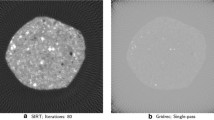Abstract
It is well known that the quantitative potential of emission computed tomography (ECT) relies on the ability to compensate for resolution, attenuation and scatter effects. Reconstruction algorithms which are able to take these effects into account are highly demanding in terms of computing resources. The reported work aimed to investigate the use of a parallel high-performance computing platform for ECT reconstruction taking into account an accurate model of the acquisition of single-photon emission tomographic (SPET) data. An iterative algorithm with an accurate model of the variable system response was ported on the MIMD (Multiple Instruction Multiple Data) parallel architecture of a 64-node Cray T3D massively parallel computer. The system was organized to make it easily accessible even from low-cost PC-based workstations through standard TCP/IP networking. A complete brain study of 30 (64×64) slices could be reconstructed from a set of 90 (64×64) projections with ten iterations of the conjugate gradients algorithm in 9 s, corresponding to an actual speed-up factor of 135. This work demonstrated the possibility of exploiting remote high-performance computing and networking resources from hospital sites by means of low-cost workstations using standard communication protocols without particular problems for routine use. The achievable speed-up factors allow the assessment of the clinical benefit of advanced reconstruction techniques which require a heavy computational burden for the compensation effects such as variable spatial resolution, scatter and attenuation. The possibility of using the same software on the same hardware platform with data acquired in different laboratories with various kinds of SPET instrumentation is appealing for software quality control and for the evaluation of the clinical impact of the reconstruction methods.
Similar content being viewed by others
References
Pupi A, De Cristofaro MTR, Formiconi AR, et al. A brain phantom for studying contrast recovery in emission computed tomography.Eur J Nucl Med 1990; 17: 15–20.
Huesman RH, Gullberg GT, Greenberg WL, Budinger TF.User manual, Donner algorithms for reconstruction tomography. Lawrence Berkeley Laboratory, University of California, 1977.
Formiconi AR, Pupi A, Passeri A. Compensation of spatial system response in SPECT with conjugate gradients reconstruction technique.Phys Med Biol 1989; 34: 69–84.
Lang K, Carson R. EM reconstruction algorithms for emission and transmission tomography.J Comput Assist Tomogr 1984; 8: 306–316.
Tsui BMW, Zhao XD, Frey EC, Gullberg GT. Comparison between ML-EM and WLS-CG algorithms for SPECT image reconstruction.IEEE Trans Nucl Sci 1991; 38: 1766–1772.
Hudson HM, Larkin RS. Accelerated image reconstruction using ordered subsets of projection data.IEEE Trans Med Imag 1994; 13: 601–609.
Passed A, Formiconi AR, Meldolesi U. Physical modelling (geometrical system response, Compton scattering and attenuation) in brain SPECT using the conjugate gradients reconstruction methods.Phys Med Biol 37: 1727–1744.
Brass LM, Walovitch RC, Joseph JL, Léveillé J, Marchand L, Hellman LS, Tikofsky RS, Masdeu JC, Hall KM, Van Heertum RL. The role of single photon emission computed tomography brain imaging with99mTc-bicisate in the localization and definition of mechanism of ischemic stroke.J Cereb Blood Flow Metab 1994; 14 Suppl 1:S91- S98.
Alexandrov AV, Grotta JC, Davis SM, Lassen NA. Brain SPECT and thrombolysis in acute ischemic stroke: time for a clinical trial.J Nucl Med 1996; 37: 1259–1262.
Dorman GA, Davis SM, Chambers BR. Trials of streptokinase in severe acute ischemic stroke.Lancet 1995; 345: 578–579.
Britton KE, Varaumo E. COST B2: the quality assurance of nuclear medicine software.Eur J Nucl Med 1993; 20: 815–816.
Author information
Authors and Affiliations
Rights and permissions
About this article
Cite this article
Passeri, A., Formiconi, A.R., De Cristofaro, M.T.R. et al. High-performance computing and networking as tools for accurate emission computed tomography reconstruction. Eur J Nucl Med 24, 390–397 (1997). https://doi.org/10.1007/BF00881810
Received:
Revised:
Issue Date:
DOI: https://doi.org/10.1007/BF00881810




